![]()
![]()
![]()
Use LEFT and RIGHT arrow keys to navigate between flashcards;
Use UP and DOWN arrow keys to flip the card;
H to show hint;
A reads text to speech;
10 Cards in this Set
- Front
- Back

|
Campin, Madonna of Humility, 1430 northern renaissance
-not ideal, everyday, relatable -nursing, not about Jesus, its about Mary -Intimate, everyday scene -excessive drapery -gratuities and geometric -very different from classical wet drapery -drapery obscures the body, ornate and decorative gothic like style -prayer book on the right, reference to private devotion -pages opened in the book -spiritual presence in the room -fire screen becomes halo -window shows typical Flemish town |
|

|
Campin, Merode Altar Piece Northern Renaissance, 1430
-invention of layer oil painting -dramatic perspective -trying to show a lot going on -slanted perspective -tilted table -disguised/pervasive symbolism -everyday objects that have an everyday meaning -constantly reinforce religious ideas (Jesus is everywhere) -candle, pot, -rose garden, Mary rose without thorns -messenger bird |
|
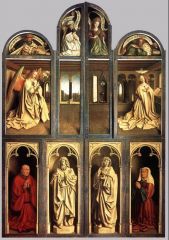
|
Ghent Altarpiece, Jan Van Eyck Northern Renaissance, 1430
-outside vs. inside – bottom five panels are -grisaille –three tiers crown -patron saints on the bottom –the crown is waiting for Jesus in heaven –one pearl is reflective with portrait of artist -annunciation -back room -Jesus the lamb -dedicated to patron saints of Ghent (the two Johns) - cohesive space -sallow space even with perspective -frame of the poliptych -orthogonals lead to one point perspective -different horizon line in the side images (the angling of the floor is different) brings into question whether or not this is one or two artists |
|
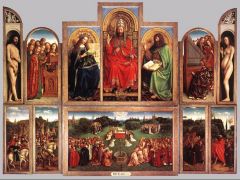
|
Ghent Altarpiece, Jan Van Eyck Northern Renaissance, 1430
-outside vs. inside – bottom five panels are -grisaille –three tiers crown -patron saints on the bottom –the crown is waiting for Jesus in heaven –one pearl is reflective with portrait of artist -annunciation -back room -Jesus the lamb -dedicated to patron saints of Ghent (the two Johns) - cohesive space -sallow space even with perspective -frame of the poliptych -orthogonals lead to one point perspective -different horizon line in the side images (the angling of the floor is different) brings into question whether or not this is one or two artists |
|
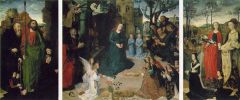
|
Hugo van der Goes, Portinari Altarpiece, 1474 (INSIDE)
-nativity on the inside -on the outside the patrons are seen -hierarchy of size (patrons are smaller than holy figures) -patron saints of the church/family/child barring -saint Margret is the saint of childbirth because she was eaten my a dragon -Italian feel in the background (open landscape) (OUTSIDE) -commissioned by a guy who was involved with the medici’s -closed outside -grisaille style and subdued color -painted statue looking -the angel and mar each have their own spaces even though they are interacting -setting is sparse, parried down -kind of statues found on outside and inside of churches -sense of movement that would be impossible with real sculpture, not balanced -dove gives sense of movement as well |
|
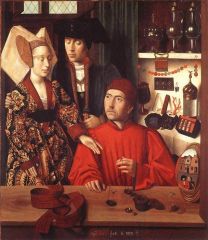
|
Petrus Christus, St. Eligius, 1449, Northern Renaissance
-metal working -goldsmith’s guild - -was able to shoe a rowdy horse -convex mirror -picking up some jewelry -document of marriage -in the mirror normal, not ornate people -everyday peoples -two suspicious figures in the mirror - slight crack in the mirror -adds another perspective -seen as a Magical thing |
|

|
Rogier van der Weden, The Deposition, 1435, Northern Renaissance
-commissioned by the archer’s guild -made to fit into a preexisting frame -details on the corners look like bows -drapery is exceissive -mary is not lookin too hot -shape of her body is similar to Jesus -gold background with a real world ground -connection between spiritual and real -typical town –dude is peeing in the corner (everyday scenery) |
|
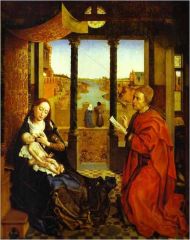
|
Rogier van der Weden, St Luke Drawing a Portrait of the Virgin Mary, 1435, Northern Renaissance
-for the artist guild -gives their profession religious and spiritual significance -something rogier is st luke in this -mirror symbolizes mary |
|
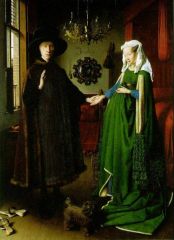
|
Jan Van Eyck, Self Arnolfini Portrait northern renaissance, 1435
-Signed the wall -view in the mirror of painter and people -we don know anything, it’s a total anomaly -possibly had a companion piece with a woman bathing -Wedding portrait –mirror with rosary beads and passion scenes -its Jan because he is wearing red -maybe a promise of marriage -bed finial st Margaret who is patron saint of childbirth -oranges could be fertility and/or wealth |
|

|
Jan Van Eyck, Self Portrait and Margret Van Eyck northern renaissance, 1430
-Inscription on frame with signature -very proud and gives character -inscription on top says “I do as I can” -humility |

